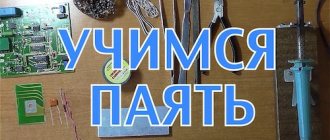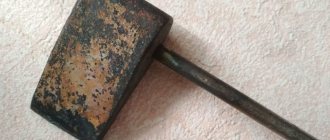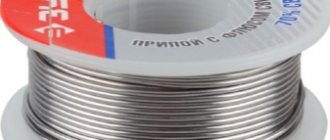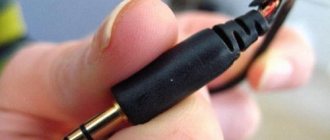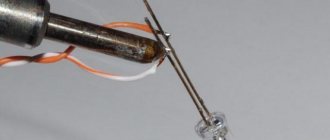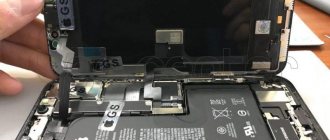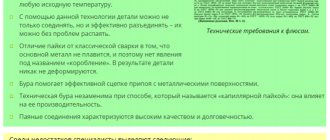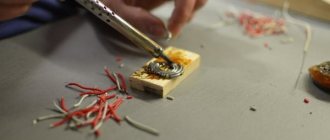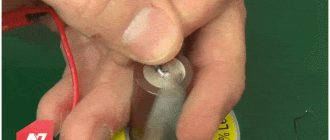Home > Electrician's Tips > How to solder correctly with a soldering iron with acid
Most often, for soldering printed circuit boards in radio engineering products and household appliances, they prefer to use ordinary pine resin rosin, but it can be replaced with other components. When molten, it promotes the spreading of tin solder along the copper traces of the board. This allows you to reliably solder the legs of radio components and the ends of connecting wires. Rosin allows you to effectively solder copper, tin and silver products. In order to solder galvanized and stainless iron, radiators, buckets, pans, various alloys, brass and other metals, you can use acid solutions.
Bottle with acid solution for soldering metals
Soldering
Solder is added to the working area heated to the required temperature using two methods:
- In liquid form, at the tip of the sting, it is used when connecting small elements. To do this, touch the wire with a sting, a piece of wire melts and, under the influence of surface tension forces, flows onto the sting, covering it with a thin layer. The drop should not hang from the tip.
- In solid form, bringing the wire to the work area. Used when working with large parts.
Brazing
How to prepare solder paste
Soldering paste is sold in radio parts stores, but you can prepare it yourself. To 32 ml of hydrochloric acid add 12 ml of ordinary water, then pieces of zinc - 8.1 g. For this, enamel dishes are used.
How to tin a soldering iron: preparation and care of the soldering iron
After the dissolution reaction is completed, tin – 8.7 g is added to the composition. When the second dissolution reaction is completed, the water is evaporated to a paste-like consistency of the solution. The paste is transferred to a porcelain container, where powder is poured, which contains:
- lead – 7.4 g;
- tin – 14.8 g;
- dry ammonia – 7.5 g;
- zinc – 29.6 g;
- rosin – 9.4 g.
This paste is mixed with 10 ml of glycerin, heated and stirred.
How to solder correctly, sequence of actions:
- The parts at the soldering site are cleaned, the wires are twisted;
- the paste is applied with a brush in a thin layer;
- the surface for soldering is heated with a plasma lighter, torch, candle or alcohol tablet, or even with matches or over a fire until the paste melts;
- After melting, the soldering elements are removed from the heat source, and the solder hardens.
The paste is very effective when it is necessary to solder copper wire, small parts made of alloys based on copper, brass, such as radiators, samovars and other products.
Possible soldering problems
If you have a certain quickly acquired skill, soldering ensures good contact. A few problems are easily identified visually. These include:
- weak heating of the connected components or the so-called. cold soldering - the solder acquires a characteristic dull color, the mechanical strength of the contact decreases, it quickly collapses;
- overheating of components - solder does not cover the surfaces at all, i.e. there is virtually no connection;
- movement of the components being connected until the solder has completely solidified - a visible sharp break in the film of the hardened solder, there is no connection.
Elimination of these defects is carried out by re-soldering.
Read also: Where to start gluing wallpaper in a room
Tips: how to do soldering correctly
After using rosin, you can try acid, but it also has a number of disadvantages. Flux is applied right before work.
There shouldn't be a lot of solder! It is required to apply an equal thin layer of material without the formation of drops and sagging, with a distinct shine.
You should always bring it to the junction of the parts being soldered, but never do this: try to apply it higher so that it flows to the junction. So it will not have sufficient strength. This is not enough for a full diffusion process.
Apply the sting to the soldering site with the entire spatula for better heat transfer and heating. You also shouldn't overheat. This comes with experience. After carrying out the work, do not forget to wipe the tinned wire from “grease stains” due to acid flux, which can also cause corrosion. Do not use acid on microcircuits and radio components. They use chemically passive rosin or resin.
For soldering, use only pure tin alloys; lead is harmful. There are a lot of videos on YouTube on soldering microcircuits, but there are no decent videos on tinning wires. So you will have to focus on the photo and develop your abilities.
Selecting a soldering iron
If you are not involved in radio work professionally (most likely this is the case, otherwise you would not have studied this material), you have in your arsenal an ordinary soldering iron in one copy. We are not talking about a soldering station at all, since it is quite expensive (albeit a very convenient kit). But for a novice master this is overkill.
Let's return to soldering irons. The classic is a nichrome heater and a copper tip. In fact, this is the best combination, but for manual control. No temperature control, smooth slow heating. At the same time, the copper tip holds the temperature perfectly, and often compensates for the heat dissipation at the soldering site. Another advantage is that the soft material allows you to mold any tip configuration. You can literally rivet and cut out a tip for a specific type of soldering.
The only drawback is that copper burns out quickly, and this type of tip is actually a consumable item. It constantly has to be sharpened with a file.
Tip: Be sure to use a hammer before shaping the tip with a file. Once the copper rod is sealed, it will last longer. A little lost time is more than compensated for by ease of use.
Phosphoric acid for flux production
The second common type of soldering acid is phosphoric acid - H3PO4. It also ideally removes oxide film from metal surfaces and prevents its renewal.
Reference: H3PO4 (orthophosphoric acid) is a component of many anti-corrosion compounds for metal processing.
To carry out high-quality soldering of elements made of nickel or chromium, such acid is used undiluted. Moreover, the composition prepared using it includes 1/3 of ethanol or ethyl alcohol.
The share of orthophosphoric acid is 32%, and 6% is rosin.
In other acid compositions used for tinning and soldering, the proportion of acid can reach 100%.
Very often, H3PO4 is combined with zinc chloride, and its mass in the finished flux can reach 50%.
The use of phosphoric acid is not limited to soldering nickel alloys; it is used to connect elements made of stainless steel, copper, aluminum and low-alloy steel.
Orthophosphoric acid is a component of the classic active flux "F-38 N", the use of which makes it possible to solder copper alloys and pure copper, various steels and chromium-nickel alloys.
“F-38 N” is an excellent option for carrying out the work process in hard-to-reach places; it has the ability to protect welded elements from corrosion.
The components of “F-38 N” are: diethylamine hydrochloride and 25% phosphoric acid.
Orthophosphorus soldering composition is characterized as fire and explosion-proof. It is recommended to store and use the product with all precautions.
In case of contact with skin, rinse for at least 10 minutes under running water.
Cleaning the soldering iron
The sponge for cleaning the soldering iron should be moistened with water. Carefully wipe the hot soldering iron tip with several quick movements. Holding the tip in one place for too long can damage the sponge.
Cleaning (wiping) the tip of a dirty soldering iron with a damp sponge
The soldering iron tip does not need to be cleaned after soldering a single element. This should be done if the tip is noticeably dirty.
Simple soldering of wires
The first example is soldering wires.
What you need
To strip the insulation from the wires you will need a stripper.
It can be used to quickly remove insulation. Side cutters, wire cutters, a knife, teeth or a soldering iron will not be able to cope with this task as easily.
Liquid rosin, or FKET, is suitable for soldering wires.
Liquid rosin best coats the wire veins. It is cheap, practical and convenient.
Which sting is better to choose
Wires require a lot of solder. A mini wave is more practical for soldering any wires than a regular cone or flat tip.
Step by step process
We remove the insulation with a stripper and twist the wires.
We apply flux to the wires to be soldered, and take the solder onto the tip. The temperature of the tip is no more than 300 °C.
With several movements back and forth we tin the twisted wires. If the solder has formed into lumps, then add it and wait for the soldering area to cool down so as not to damage the brush. Add more flux and run the soldering iron over the soldering area again. There should not be much or little solder.
It's best to tin both wires before soldering them together, but you won't be able to twist them together securely. Therefore, it is easier to immediately twist and then solder them.
Features of wire tinning
To tin such wires, you need to carefully walk over the soldering area using solder and rosin.
For soldering you will need a massive tip, a large drop of solder and liquid rosin. Flux is applied in the same way, but soldering is a little different. Now the main task is to burn the insulation. This can be done with a large drop of solder. Using longitudinal movements back and forth, apply solder to the soldering area. Insulation burns slowly. There is no need to raise the temperature above 300 °C or use acid. If we can’t tin, then we try again, but instead of rosin we use LTI-120. This flux will help tin the wires no worse than soldering acid.
Safety regulations
In the production of soldering acid, hydrochloric and phosphoric acids are used. They are very active (although phosphorus is weaker) and easily react with many chemicals. When such substances come into contact with the skin, they cause a chemical burn.
Read also: Round level for horizontal surfaces
Even when diluted, their vapors can damage the mucous membrane of the sensory organs.
Taking into account the above facts, safety rules when handling soldering acid include secure storage of the drug, the use of protective clothing and gloves, and good ventilation of the work area.
[Acid for soldering is necessary] if the use of rosin does not allow the necessary elements to be properly soldered together.
The use of soldering acid for soldering helps remove the oxide film layer from the surfaces being soldered and makes it possible to properly prepare them for joining.
As a rule, rosin is used to prepare copper parts for soldering with your own hands. But soldering acid is used for tinning not only copper, but also its alloys - bronze and brass.
And also for stainless steel, precious and ferrous metals, aluminum and nickel, even for soldering cast iron.
Fluxes and solders - how to choose the right ones
For the reasons described above, the correct choice of flux and solder is almost half the success in the soldering business. Fortunately, there are quite universal brands suitable for most tasks. The area of application of almost all fluxes and solders is clearly indicated on the labels, but some aspects of their use still need to be known.
Let's start with fluxes. They are used for etching parts, removing and dissolving the oxide film with further protection of the metal from corrosion. As long as the surface is covered with flux, you can be sure of its cleanliness, as well as that the molten tin will wet it well and spread.
Fluxes are distinguished by the type of metals and alloys of the parts being joined. Basically, these are mixtures of metal salts, acids and alkalis that actively react when heated with a soldering iron. Well, since there are quite a lot of oxide forms and contaminants, the cocktail must be specially selected for a specific type of metals and alloys.
Active flux for soldering
Conventionally, soldering fluxes are divided into two types. Active fluxes are created on the basis of inorganic acids, mainly chloric and hydrochloric. Their disadvantage is that they need to be washed off immediately after soldering is completed, otherwise acid residues cause quite severe corrosion of the connection and themselves have a fairly high conductivity that can cause a short circuit. But you can solder almost anything with active fluxes.
The second type of flux is created primarily on the basis of rosin, which can also be used in its pure form. Liquid flux is much more convenient to apply; it also contains alcohol and/or glycerin, which completely evaporate when heated. Rosin fluxes are the least effective when soldering steel, but for non-ferrous metals and alloys they are mainly used or other compounds of organic chemistry. Rosin also requires rinsing because in the long term it promotes corrosion and can become conductive by picking up moisture from the air.
Liquid and solid rosin
With solders everything is somewhat simpler. Lead-tin solders of the POS brand are mainly used for soldering. The number after the marking indicates the tin content in the solder. The more it is, the higher the mechanical strength and electrical conductivity of the connection and the lower the melting temperature of the solder. Lead is used to normalize the solidification process; without it, the tin may crack or become covered with needles.
Solder POS-61 with rosin inside
There are special types of solders, primarily lead-free (BP) and other non-toxic ones, in which lead is replaced by indium or zinc. The melting point of BP is higher than that of conventional ones, but the connection is stronger and more resistant to corrosion. There are also low-melting solders that spread already at 90–110 ºС. These include Wood and Rose alloys; they are used for soldering components that are sensitive to overheating. Special solders are mainly used in soldering radio equipment.
Alloy Rose
Purpose
To prepare parts for applying solder, it is necessary to clean them of particles of foreign materials - dust, sand, water. In addition, it is necessary to remove the oxide film from the surface, which is present on almost all metals.
And if the first condition is easy to cope with mechanically, using a file, needle file, or sandpaper, then the second condition is difficult to fulfill without the use of chemical compounds - an oxide film very quickly appears on the surface of the metal.
Substances that remove film and prevent the formation of a new one are called fluxes, and the most effective of them is soldering acid. It is an active flux, that is, during soldering it chemically affects the composition of the metal surface.
Professionals never question why soldering acid is needed; they know very well that very often it is impossible to complete the assigned tasks without it.
Soldering acid is used for the following metals:
- copper and its alloys;
- nickel;
- iron;
- structural steel;
- alloys of non-ferrous metals.
If copper or brass parts are successfully soldered with borax, then it is often possible to solder aluminum or steel workpieces to each other only using soldering acid. Upon completion of work, the active flux must be washed off with water containing a small amount of alkali.
You can buy acid in stores, or make it yourself using chemical reagents. Although purchasing raw materials can be more expensive than ready-to-use flux.
Where to learn to solder
You can train at home by soldering ordinary electrical wires. The main thing is to follow the safety instructions.
The work may require:
- soldering iron (according to professionals, to work with small wires in electronics and radio engineering, a tool with a power of 20-40 W will be sufficient);
- pliers;
- knife;
- scissors;
- set of files;
- sandpaper;
- insulating tape;
- rosin;
- solder.
The question “how to learn to solder” will be resolved after several training sessions. The beginner will gain confidence and experience. Step-by-step soldering instructions can help him with this.
How to solder correctly with a soldering iron
Take the twig with pliers and coat it with flux. Either cover it with acid with a brush, or melt rosin and apply it to the vein.
2. Next, take a little solder onto the soldering iron tip to form a droplet. It shouldn't drip. And then move the sting along the twig, turning it a little, so that the entire wire is covered with a thin layer of tin without gaps.
Wait until it cools down and repeat the operation with all the remaining ones. The photo shows stains left due to the use of acid. Additional wiping will be required if a reactive flux is used.
3. Now the most difficult part, you need to connect the twigs into corners, then into 2 squares.
4. Place one square on a metal plane (so as not to spoil the table) and attach 4 ribs.
5. Solder the second square on top. Mission Complete.
To check the quality of the work, take your creation and squeeze it in your hands. If it's dented, but not a single rib has fallen off, congratulations. It is advised to repeat until victory, but try to do it at least 2-3 times.
There should be no solder drops in the corners.
You yourself will notice how the tinned wires will have a perfectly even, shiny layer and the joints of the parts will become stronger. And when you get used to holding parts straight, you can do anything.
DIY hydrochloric acid flux
Often, to process the parts being soldered, a flux is purchased, which is commercially available and is simply called soldering acid.
The manufacturer supplements the product with instructions on the conditions of its use, which makes it easy to navigate its purpose.
Usually this is tinning and soldering of stainless steel, silver, copper, aluminum and various alloys.
In the production of flux, hydrochloric acid is used, in which zinc is dissolved, resulting in a base - a zinc chloride compound. It is quite easy to make such a composition at home with your own hands.
To prepare the composition you need to take:
- 1 liter of HCL (concentrated hydrochloric acid);
- 412 g Zn (zinc).
Next you will need a container made of glass, ceramic or porcelain. First, zinc is placed in the dishes, then hydrochloric acid is poured.
It is very important to prepare the composition with care; fill ¾ of the container with acid.
Zinc and hydrochloric acid can be bought in special chemical stores, but if you have old AA batteries at home, Zn can be easily obtained from them.
After the reaction of dissolving zinc in hydrochloric acid occurs, the evolution of hydrogen will stop.
That is, bubbles will no longer form in the liquid, it will become transparent. The prepared soldering acid composition is carefully poured into a tightly sealed glass container.
Precautionary measures: when making flux, it is recommended to be near running water; if the composition suddenly gets on the skin or, even worse, in the eyes, it is necessary to rinse them with plenty of water.
By the way, hydrochloric acid in its pure form can be used as a flux, provided that iron parts are processed.
